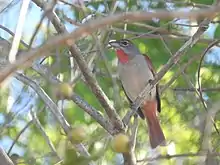| Rose-throated tanager | |
|---|---|
 | |
| Scientific classification | |
| Domain: | Eukaryota |
| Kingdom: | Animalia |
| Phylum: | Chordata |
| Class: | Aves |
| Order: | Passeriformes |
| Family: | Cardinalidae |
| Genus: | Piranga |
| Species: | P. roseogularis |
| Binomial name | |
| Piranga roseogularis Cabot, 1846 | |
 | |
The rose-throated tanager (Piranga roseogularis) is a medium-sized songbird in the family Cardinalidae, the cardinals or cardinal grosbeaks. Endemic to the Yucatán Peninsula in Central America, it is found in Belize, Guatemala, and Mexico.[2][3] The male has greyish plumage with a deep rose throat and crown, while the female is similar but for a yellow crown and throat.
Taxonomy and systematics
American ornithologist Samuel Cabot III described the rose-throated tanager in 1846, having seen a pair in the Yucatán Peninsula and shooting the male.[4] A 2019 genetic study using mitochondrial DNA showed that it was a basal (early offshoot) of a lineage that gave rise to the scarlet, hepatic, summer, western and flame-colored tanagers.[5]
The rose-throated tanager and the other species of genus Piranga were originally placed in the family Thraupidae, the "true" tanagers. Since approximately 2008 they have been placed in their current family, the Cardinalidae.[6][7][2]
The rose-throated tanager has three recognized subspecies, the nominate Piranga roseogularis roseogularis, P. r. tincta, and P. r. cozumelae.[2]
Description
The rose-throated tanager is 16 cm (6.3 in) long and weighs 21 to 30 g (0.74 to 1.06 oz). The nominate male's crown and throat are deep rose and the rest of the body shades of gray. The folded wings and tail appear crimson. The female's crown and throat are yellow. The upper parts are yellowish olive and the underparts mostly pale gray to whitish. Its folded wings and tail are yellowish. P. r. tincta has the same color schemes as the nominate but is paler, and P. r. cozumelae is darker.[3]
Distribution and habitat
The nominate rose-throated tanager is found in the northern, drier, part of Mexico's Yucatán Peninsula. P. r. tincta is found in the more humid southern part of the peninsula and in northern Guatemala and Belize. P. r. cozumelae is restricted to the islands of Mujeres and Cozumel off the east coast of the peninsula. The species primarily inhabits the edges of semi-humid and humid mature forest and the undergrowth of scrubby forest, although it sometimes is found in areas with scrub and only scattered trees. In elevation it ranges from sea level to 250 m (820 ft).[3]
Behavior
Feeding
The rose-throated tanager forages throughout most levels of the forest, in undergrowth, saplings, mid-level, and the canopy. In the last it often joins mixed-species foraging flocks. It has also been observed following army ant swarms. Details of its diet have not been published.[3]
Breeding
No information on the rose-throated tanager's breeding phenology has been published.[3]
Vocalization
The rose-throated tanager's song is "a rich warbled 'whee chee cheer-el-chee cheer-el-cheu chee-el-chu...'".[8] Calls include a nasal "rreh" and a mewing "myaaa".[9][10][3]
Status
The IUCN has assessed the rose-throated tanager as being of Least Concern.[1] "Although portions of the area within its range are subject to considerable human-caused environmental pressures, the species does not appear to be at any immediate risk."[3]
References
- 1 2 BirdLife International (2020). "Piranga roseogularis". IUCN Red List of Threatened Species. 2020: e.T22722461A136813408. doi:10.2305/IUCN.UK.2020-3.RLTS.T22722461A136813408.en. Retrieved 26 November 2022.
- 1 2 3 Gill, F.; Donsker, D.; Rasmussen, P. (January 2021). "IOC World Bird List (v 11.1)". Retrieved January 14, 2021.
- 1 2 3 4 5 6 7 Hilty, S. (2020). Rose-throated Tanager (Piranga roseogularis), version 1.0. In Birds of the World (J. del Hoyo, A. Elliott, J. Sargatal, D. A. Christie, and E. de Juana, Editors). Cornell Lab of Ornithology, Ithaca, NY, USA. https://doi.org/10.2173/bow.rottan1.01 retrieved May 15, 2021
- ↑ Cabot, Samuel (1846). "Description of Pyranga roseo-gularis (Rose Throated Tanager)". Boston Journal of Natural History. 5: 416.
- ↑ Campillo, Luke C.; Burns, Kevin J.; Moyle, Robert G.; Manthey, Joseph D. (2019). "Mitochondrial genomes of the bird genus Piranga: Rates of sequence evolution, and discordance between mitochondrial and nuclear markers". Mitochondrial DNA Part B. 4 (2): 2566–2569. doi:10.1080/23802359.2019.1637286. PMC 7687373. PMID 33365629.
- ↑ Remsen, J. V., Jr., J. I. Areta, E. Bonaccorso, S. Claramunt, A. Jaramillo, D. F. Lane, J. F. Pacheco, M. B. Robbins, F. G. Stiles, and K. J. Zimmer. Version 19 January 2021. A classification of the bird species of South America. American Ornithological Society. https://www.museum.lsu.edu/~Remsen/SACCBaseline.htm retrieved January 19, 2021
- ↑ R. Terry Chesser, Richard C. Banks, F. Keith Barker, Carla Cicero, Jon L. Dunn, Andrew W. Kratter, Irby J. Lovette, Pamela C. Rasmussen, J. V. Remsen, Jr., James D. Rising, Douglas F. Stotz, and Kevin Winker. "Fiftieth supplement to the American Ornithological Society’s Check-list of North American Birds". The Auk 2009, vol. 126:705–714 retrieved May 15, 2021
- ↑ "XC470273 Rose-throated Tanager (Piranga roseogularis)" – via www.xeno-canto.org.
- ↑ "XC332435 Rose-throated Tanager (Piranga roseogularis)" – via www.xeno-canto.org.
- ↑ "XC332798 Rose-throated Tanager (Piranga roseogularis)" – via www.xeno-canto.org.
External links
 Media related to Piranga roseogularis at Wikimedia Commons
Media related to Piranga roseogularis at Wikimedia Commons Data related to Piranga roseogularis at Wikispecies
Data related to Piranga roseogularis at Wikispecies
